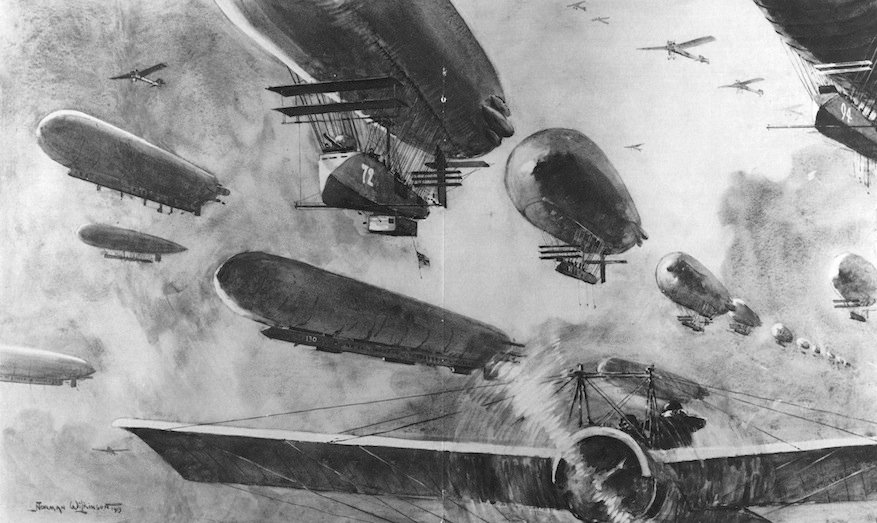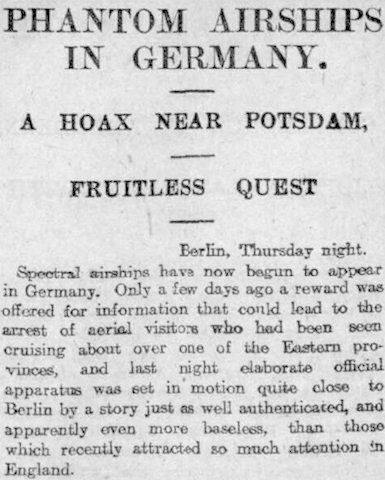
For the first time, a phantom airship has been seen over the very heart of London, ‘A full week behind the provinces’, as the Daily Express says (p. 1). Previously, no reports came from closer than Croydon (South London) or Hendon (North London), about a month ago. Yet relatively few newspapers seem to be interested in the story. The Daily Mirror, surprisingly in view of its sceptical attitude towards the whole subject, is one, though its account is brief. More substantial (and identical) reports appear in the Irish Times, the Liverpool Echo, and the Dundee Courier, which last says (p. 5; above):
Reports received from a number of independent sources go to show that mysterious aerial lights were observed over central London between 7 and 7.30 last evening [7 March 1913] by a large number of persons
The sky is described as being ‘overcast’ and ‘inclined to be misty’, thus ruling out the ‘possibility of sky-gazers being misled by a bright star’. But otherwise, ‘little definite can be said’.
A large crowd collected in St Bride Street on the report that the much-talked-of ‘mystery airship’ had arrived over London, Several persons declared that they had seen a bright light in the sky immediately over the thoroughfare, and one or two affirmed that they had made out the body of an airship, the envelope, according to their statements, being of a whitish colour.
Shortly afterwards what was evidently ‘the same strange light’, ‘variously described as a “searchlight” and as an occulting light of the headlight type’, was seen from Paternoster Row, ‘suggesting that the airship, if airship there really was, had the dome of St Paul’s as its objective’.
A lift attendant employed in a Ludgate Circus office stated that his attention was attracted by a bright flash across one of the windows on the topmost floor of the building in question.
He ran to the window, and gathered the impression that a searchlight was being operated from some elevated position to the south of London, but he could see no airship, and the flash was not repeated.
A youth who claimed to have seen the airship from Paternoster Row stated that the flashing of a light into the roadway from a point directly above him caused him to look up, when he made out something moving slowly and irregularly overhead carrying a light, which was obscured every now and again, at the rear end.
Though it should be noted that while Paternoster Row is adjacent to the cathedral, the claim in the Courier‘s headline that the airship ‘is Stated to Have Flown Over St Paul’s Cathedral’ seems to be only an inference, as nobody actually says they saw that happen. The article’s conclusion is that ‘it seems possible that a flight may have been made around St Paul’s, the aeronauts, whoever they were, approaching the Cathedral from the north-west and leaving in a south-westerly direction’.
A possible explanation for the general lack of interest in the London scareship may lie in the fact that there already seems to be a plausible explanation available. In fact, the Globe notes that ‘Three solutions are offered to us today’ for the ‘light seen above the roofs of Holborn last night’, and invites its readers to ‘TAKE YOUR CHOICE’ (p. 2). One is the theory that it was an Army airship. The Courier (et al) notes that ‘Similar flights [to central London] have been made on several occasions by the small army airships’, and also runs an additional article entitled ‘PROBABLE EXPLANATION’ showing that an Army airship was in operation yesterday. The version in the Irish Times is fullest (p. 8):
A probable explanation of the mysteriously-flashing searchlight, reported as seen in the sky over central London, is forthcoming at a late hour. The War Office Communiqué, issued last night, furnished a possible clue to the identity of any airship which might have visited London, by reference to the fact that an airship was employed on Salisbury Plain for tests of rockets as warnings to aircraft for day and night use. Subsequent enquiries tend to confirm the suggestions that possibly this airship made a trip to London and back. Questioned, the military authorities at Bulford Camp stated that there had been much activity there, that aeroplanes and aircraft had been manœuvring, and that it was quite possible that an airship from either Larkhill or Aldershot had made a trip to and from London. It was added that the conditions for such a flight were quite good on the plain.
Another theory is proposed by the Daily Express, that a balloon used for advertising purposes was responsible (p. 1):
At seven o’clock last night, in a line due north of the Cheshire Cheese, in Fleet-street, a cylindrical balloon showing a bright light underneath its body was seen moving against the dark blue night. These movements were limited and eccentric, and probably due to the pulling of a rope attached to the balloon amidship.
The sinister sausage hovered over Holborn for half an hour, a source of great alarm to all the Boy Scouts who had come out without their big pocket-knives. Then before the advertiser had time to pull down the rope the balloon went off with a bang, and Londoners were able to sleep soundly in their beds; but not until a news agency had sent out a double alarm to the effect that a strange airship was hovering over London.
However, even apart from the jocular tone (‘sinister sausage!’), it’s difficult to know how seriously to take this: no other source mentions a ‘bang’, and if it was an advertising balloon then it seems to have been a rather ineffective one, given that nobody seems to know what it was advertising. Then again, it is perhaps more plausible than the third explanation, proposed by the (presumably Daily) Chronicle as quoted by the Globe, which is that the airship was pure imagination based on nothing at all, not even misperception (p. 2):
A ‘mystery airship’ hoax was worked off on a crowd of people in London last night by a meat porter at the Smithfield Markets, who declared that he could see such a craft hovering over Farringdon-street. The point of the joke was that the majority of the people who gathered agreed with the porter that they also could see a moving and luminous object, although there was nothing in the sky to corroborate such a view — not even the planet Venus. When the crowd gathered they seemed to take the presence of an airship for granted. At first some said they could not see it, but as others said they could the former must have felt the reputation of their eyesight at stake. Consequently they became converts to the delusion.
It seems unlikely that a crowd gathering at the Smithfield Markets could influence a lift operator in a building on Ludgate Circus and in Pasternoster Row, both about 300 metres away. But the sequence of events is not clear and perhaps a rumour of the airship spotted in one locale had time to make its way to the others, causing people to be on the lookout for something out of the ordinary.
There are two other new mystery airships reported today, both in the Dundee Courier. One was seen at Cardiff, which was the scare’s epicentre early on, but has been quiet for a whole month (p. 5):
Another sensation was caused in Cardiff last night [7 March 1913], about half-past ten, when a ‘mystery’ airship, according to a number of persons, made its appearance over the city.
The craft, carrying a dull, yellowish light, travelled from the English coast across the Bristol Channel, and disappeared in a north-easterly direction.
The other was seen at Broughty Ferry, a suburb of Dundee, ‘despite the Government ban against such craft coming within sight of Broughty Castle‘. When exactly is not stated. The person who saw it is James M’Intosh:
Following his occupation of night watchman over some road alterations at the back of Reres Hill, he descried in the sky a trailing light to the north-west. It became brilliant at intervals, and he was able to make out a large cigar-shaped object.
He asserts that occasionally the light assumed the appearance of an electric searchlight. The airship manœuvred about for an hour, and finally headed north against the wind.
Otherwise there is generally the same old stuff in today’s papers. Flight reprints the Review of Review illustrations of the disparity between Britain’s airship fleet and everyone else’s from two weeks ago, explaining that ‘The reported flights made over England by unknown airships have led the Government to construct a Bill dealing with the matter’ (p. 275). The Connacht Tribune‘s London correspondent says that ‘It now turns out, as I expected, that no air-ship at all was seen or heard!’ but equally that ‘The scare has served its purpose. The Tory Press, headed by the “Pall Mall Gazette” and the “Observer,” have used it to drive home the urgent necessity there is for conscription — for more air craft, and for more ships!’ — oddly, since the Observer has taken little interest in the phantom airships (p. 4). An article on the military balloon lost from Aldershot, which appears in both the Donegal News (p. 6) and the Ulster Herald (p. 6), ends by suggesting ‘Perhaps it will turn up as a mystery airship’. The Irish Independent and the Western Times get around to reporting the box kite hoax at Grimsby; ditto for the Yorkshire Gazette and the Othello sighting. The only novel note is struck by the last-named paper, which has a sardonic account of a lively meeting of the Land Union at York — it is ostensibly a non-party organisation devoted to protecting the interests of landowners of all classes, and yet the government’s land taxes were attacked! and the working classes sneered at! (p. 6):
Judging from all this excitement one would imagine that landowners were being taxed out of existence, and that the cost of Old Age Pensions, National Insurance, additional dreadnoughts, to say nothing of mysterious airships, was being placed upon land. It is, therefore, disappointing to find […] that the particular land taxes objected to have only produced a total for the whole country of £67,000.
Somehow it doesn’t seem likely that ‘mysterious airships’ were actually mentioned at the meeting. Rather this is an example of ridicule by association: the landowners’ supposedly onerous burden is as non-existent as the scareships.
![]() This work is licensed under a Creative Commons Attribution-NonCommercial-NoDerivatives 4.0 International License.
Permissions beyond the scope of this license may be available at http://airminded.org/copyright/.
This work is licensed under a Creative Commons Attribution-NonCommercial-NoDerivatives 4.0 International License.
Permissions beyond the scope of this license may be available at http://airminded.org/copyright/.






Pingback: Monday, 10 March 1913